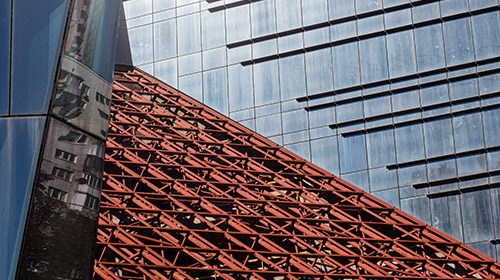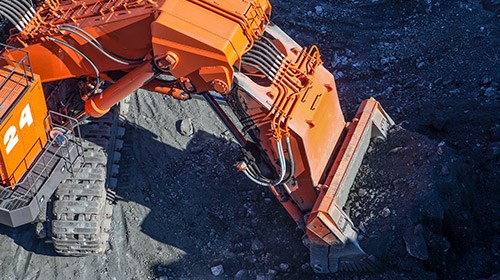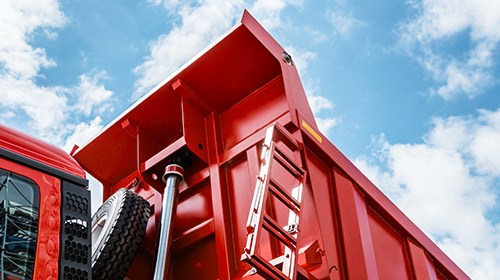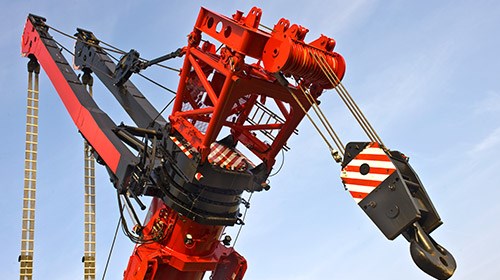High-strength rolled steel products are defined as having a yield strength of more than 300 MPa and a tensile strength of up to 2,500 MPa as delivered. High-strength steel plates are widely used in various industries due to their lower steel intensity, longer service life, and lower production and operating costs compared with products from conventional steel grades. Strength properties of steel are achieved through alloying, special hot-rolling conditions (controlled, normalised or thermomechanical rolling) and heat treatment (quenching and tempering, normalising). Aside from high strength, the steel has a higher impact toughness (at negative temperatures as well), good ductility and weldability.
Quenched and tempered (Q&T) and thermomechanically rolled high-strength products are most in demand in this segment.

Application




High-strength steel applications
The use of high-strength quenched steel with a higher wear resistance to manufacture and repair steel structures and machine components has numerous advantages:
-
Reduced weight of products and structures while maintaining strength characteristics
-
Increased payload capacity
-
Reduced cost of transportation, assembly and installation
-
Reduced cost of repair and maintenance
-
Combined wear, crack and deformation resistance
Given the aforementioned properties, high-strength steel delivered in a quenched and tempered condition is widely used in heavy engineering, construction and other industries. The manufacturing of heavy-duty above-ground, underground and lifting machinery accounts for more than 70% of quenched steel plate consumption.
|
Application of high-strength quenched and tempered steel |
Examples of applications |
|
Manufacturing of heavy-duty above-ground machinery |
Excavator buckets and other attachments Dump truck bodies Smoothing plate for an asphalt machine Grader blade |
|
Manufacturing of underground machinery |
Connecting parts of conveyors Reinforcement of the load-carrying parts of mining machines Attachments of mining equipment |
|
Manufacture of lifting equipment |
Harbour crane clamshell Load beading parts of bridge cranes Crane booms, etc |
|
Mining industry |
Receiving bins and screens Buffer tanks and vibration feeders Cone crushers |
|
Heavy and general-use machine-building |
Wear parts of concrete plant equipment Plates for concrete mixers, tanks for gravel charging Lining of railcars and buckets and bodies of wheeled equipment Wear parts of machines and equipment |
|
Construction |
Load-bearing parts of offshore platforms Elements of wind-power generator towers Elements of bridges and trestles |
|
Repairs, distribution |
Refurbishment of individual wear parts of the aforementioned equipment at end customers’ premises or specialist repair workshops |
High-strength steel allows for significantly longer service life of equipment and machines, less frequent replacement and repairs of machinery, and less downtime.
The advantages of thermomechanically rolled products come from their key properties, such as low carbon equivalent, high strength and high impact toughness. Compared with conventional steels, ТМСР rolled products demonstrate greater efficiency during processing: reduced costs for welding consumables, no need for preheating steel and additional heat treatment, reduced overall steel intensity of structures, and shorter project implementation time.
High-strength steel is used mainly in the construction and different engineering industries.
|
Application of high-strength thermomechanically rolled steel |
Examples of applications |
|
Industrial and civil construction |
Construction steel structures – columns, trusses, elements of floors, etc Elements of bridges and trestles |
|
Offshore structures |
Load-bearing parts of offshore platforms Components of offshore drilling rigs |
|
Wind generators |
Elements of wind-power generator towers |
|
Heavy and general-use machine-building |
Booms of mobile cranes, frames of trucks and agricultural equipment, strength members Lining of side and end walls of railcars, open railcar frames Components of turbines, hydrogenerators and turbogenerators |
|
Repairs, distribution |
Refurbishment of individual wear parts of the aforementioned equipment at end customers’ premises or at specialist repair workshops |
Using high-strength thermomechanically rolled steel instead of regular structural steel grades substantially reduces the steel intensity of civil structures due to the use of columns with thinner walls and flanges, yet the same compression strength performance. For example, the use of TMCP plates to make welded columns of modern commercial high-rise buildings enables 20-30% savings in rolled steel products. When used in open wagon structures, TMCP plates make them lighter (and increase their payload capacity correspondingly) by 30-35%.
High-strength steel classification and properties
High-strength steel delivered in a quenched and tempered condition is manufactured in accordance with the standards EN 10025-6, DSTU EN 10025-6, ASTM A514/А514М, ASTM A517/А517М, GOST 19281, etc, as well as manufacturers' internal regulations.
|
Standard |
High-strength steel grades |
Approximate level of mechanical properties as per the standard |
|
|
Yield strength, MPa |
Tensile strength, MPa |
||
|
EN 10025-6 DSTU EN 10025-6 |
S460Q, S460QL, S460QL1 |
No less than 460 |
550-720 |
|
S500Q, S500QL, S500QL1 |
No less than 500 |
590-770 |
|
|
S550Q, S550QL, S550QL1 |
No less than 550 |
640-820 |
|
|
S620Q, S620QL, S620QL1 |
No less than 620 |
700-890 |
|
|
S690Q, S690QL, S690QL1 |
No less than 690 |
770-940 |
|
|
S890Q, S890QL, S890QL1 |
No less than 890 |
940-1100 |
|
|
S960Q, S960QL |
No less than 960 |
980-1150 |
|
|
ASTM A514/A514M |
A514-B MT |
620-690 |
690-895 |
|
A514-Q MT |
620-690 |
690-895 |
|
|
A514-H MT |
620-690 |
690-895 |
|
|
A514-F MT |
620-690 |
690-895 |
|
|
A514-E MT |
620-690 |
690-895 |
|
|
ASTM A517/A517M |
A517-F |
620-690 |
725-930 |
|
A517-B |
620-690 |
725-930 |
|
|
A517-Q |
620-690 |
725-930 |
|
|
ASTM A537/A537M |
A537, categories 2,3 |
380-415 |
550-690 |
|
GOST 6713 |
10HSND |
No less than 390 |
530-685 |
|
15HSND |
No less than 345 |
490-685 |
|
|
GOST19281 |
10HSND |
No less than 390 |
No less than 510 |
|
15HSND |
No less than 345 |
No less than 490 |
|
|
09G2S |
No less than 350 |
No less than 500 |
|
|
16G2AF |
No less than 450 |
No less than 600 |
|
|
Spec. 14-1-5334-96 |
16HGMFTR |
No less than 580 |
No less than 680 |
|
Spec. 14-1-5517-2005 |
16H2GSB |
590-835 |
690-930 |
|
Spec. U 77-096-173-2001 |
25HGSR |
No less than 620 |
No less than 800 |
|
Spec. U 27.1-26416904-150:2005 |
06G2B |
No less than 440 |
No less than 540 |
|
06GB |
No less than 355 |
No less than 450 |
|
High-strength steel delivered in a thermomechanically rolled condition is manufactured in accordance with EN 10025-4, DSTU EN 10025-4 and EN 10149-2, as well as other regulatory documents and under own brands of manufacturers.
|
Standard |
High-strength steel grades |
Approximate level of mechanical properties as per the standard |
|
|
Min yield strength, MPa |
Tensile strength, MPa |
||
|
EN 10149-2 |
S315MC |
315 |
390-510 |
|
S355MC |
355 |
430-550 |
|
|
S420MC |
420 |
480-620 |
|
|
S460MC |
460 |
520-670 |
|
|
S500MC |
500 |
550-700 |
|
|
S550MC |
550 |
600-760 |
|
|
S600MC |
600 |
650-820 |
|
|
S650MC |
650 |
700-880 |
|
|
S700MC |
700 |
750-950 |
|
|
S900MC |
900 |
930-1200 |
|
|
S960MC |
960 |
980-1250 |
|
|
EN 10025-4, DSTU EN 10025-4 |
S275M, S275ML |
275 |
370-530 |
|
S355M, S355ML |
355 |
470-630 |
|
|
S420M, S420ML |
420 |
520-680 |
|
|
S460M, S460ML |
460 |
540-720 |
|
Production of high-strength steel plates
High-strength steel is manufactured in reversing mills by hot deformation of semi-finished steel products such as continuously cast or rolled slabs. Plates undergo strengthening treatment either in the final stages of rolling and cooling in the mill or by heat treatment offline.
|
|
Quenched and tempered (Q&T) high-strength steel |
Thermomechanically rolled |
|
Technology and properties |
Heat treatment offline or direct quenching Increased wear resistance of rolled products Combined wear, crack and deformation resistance |
Special in-line rolling conditions Low carbon equivalent High strength and impact toughness |
|
Benefits to consumers |
Reduced weight while maintaining strength properties Increased payload capacity Reduced material inputs |
Reduced welding time and costs No additional heat treatment Reduced weight of steelworks compared with conventional steel grades Possibility of cold-forming |
Quenching is heating steel above the temperature of phase transformation with consequent quick cooling at a speed above the critical (in water, oil, polymer or ether mix, etc). A heating temperature and cooling medium are selected based on the chemical composition and required structural condition of steel. After quenching, steel acquires non-equilibrium metastable structure and has greater strength (up to 2,500 MPa), hardness (up to 600-650 Vickers), wear resistance and brittleness. Quenching can involve the dedicated heating of steel after rolling or the use of rolling heat (known as direct quenching).
The thermomechanical controlled process (rolling; TMCP) requires meticulous control of the plate temperature and deformation during rolling. Properties obtained after TMCP cannot be accomplished by normalising or other types of heat treatment. The final fine-grained microstructure of steel is obtained by micro-alloying, rolling in a certain temperature range and controlled cooling (as well as accelerated cooling using an air-water mix).
Due to their high strength, weldability and resistance to brittle cracking, TMCP steel products can be applied in structures with operating temperatures of up to -50 °C with guaranteed values of impact strength.
Buy high-strength steel from the manufacturer
Metinvest produces low-alloy and alloyed high-strength steel in accordance with the requirements of international standards and customers' specifications. The products can be delivered after special types of rolling (controlled, thermomechanical and normalised rolling) and heat treatment offline (quenching and tempering, normalising, etc). High-strength steel can be purchased through the global sales network of 38 sales offices in Europe, Asia, Africa and America, as well as 16 metal service centres in Ukraine, and authorised dealers.
Get in touch
Find the nearest office
Subscribe to our newsletter